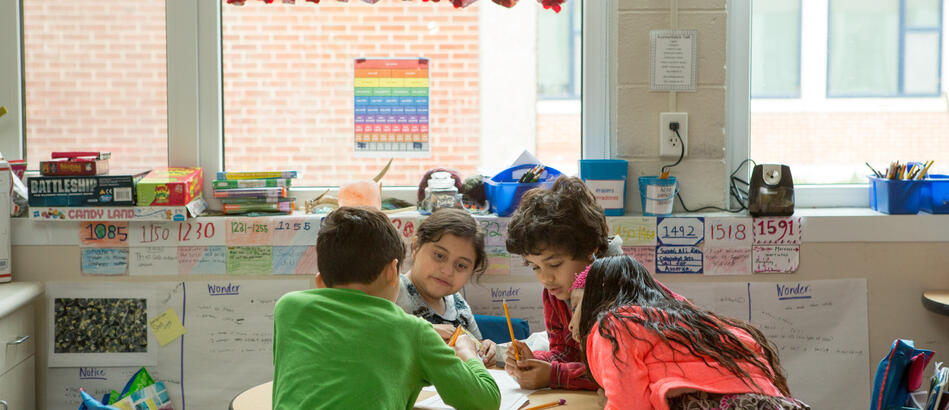
The COVID-19 pandemic resulted in historic drops in academic achievement for America’s students. However, not all of the pandemic’s effects on students were academic. COVID-19-related school closures, economic upheavals, isolation, and stress led to a rapid falloff in what had already been a decade-long decline in students’ mental health. In 2021, 42% of high school students felt persistently sad or hopeless, 29% experienced poor mental health, and 22% seriously considered attempting suicide (CDC, 2023).
Faced with both academic and social-emotional needs, the Illinois State Board of Education (ISBE) is using multiple strategies to address recovery. ISBE is using federal relief funds to support four state-led initiatives:
- high-impact tutoring ($59.5 million),
- additional formative assessments to help teachers pinpoint knowledge gaps and adjust instruction ($6.8 million),
- educational services for students in early childhood settings and those transitioning to postsecondary settings ($21.5 million), and
- social and emotional learning ($136.5 million).
The social and emotional learning component is the largest part of Illinois’ pandemic recovery investment. This is consistent with Illinois’ recognition as one of the top five states in the nation in terms of policies that address facets of the youth mental health crisis (for example, the ratio of school mental health professionals to students, regular staff training in mental health, substance use, and suicide prevention, or mental health education) (Hopeful Futures Campaign, 2022). Illinois has stressed that not only is social and emotional learning critical to do well, it is also critical to do first, so that investments in instruction may have a better chance at taking hold among stressed and disengaged students.
Social and emotional learning is not only critical to do well, it is critical to do first so that investments in instruction can take hold.
Research indicates that Illinois may have chosen wisely. The CDC reported that students who felt more connected at school were less likely to report poor mental health even when they attended school virtually (Jones et al., 2022). Social and emotional supports in schools can help students achieve that kind of school connection. Evidence for the value of social and emotional learning approaches comes from a recent synthesis of 424 studies involving 575,361 students across 53 countries. The synthesis showed that school-based social and emotional learning programs produced significant improvements in students’ social skills, behavior, emotional distress, school climate and safety, peer relationships, school functioning, and academic achievement (Cipriano et al., 2023). Social and emotional interventions had the most powerful effects when they:
- were sequenced using a coordinated set of activities
- used active forms of learning
- focused on developing personal or social skills
- targeted specific social and emotional skills rather than positive development in general
- were implemented with quality
- were delivered by classroom teachers
- integrated social and emotional lessons into academic content
The research-practice partnership between ISBE and the American Institutes for Research focuses on a non-academic approach to pandemic recovery. The project aims to learn what social and emotional learning approaches are being used across the state. We will also examine whether these approaches are associated with any changes in student social-emotional skills and school staff’s well-being, as well as more traditional measures of school success (achievement, attendance, graduation).
What can your school do?
The list below presents some fundamental approaches that that schools may consider using to address student re-engagement and student mental health.
- Use a multi-tiered system of supports (MTSS) to organize interventions and approaches for students
- Screen for mental and behavioral health
- Partner with community-based mental health organizations
- Build referral pathways for in-school and community-based services and supports
- Increase mental health awareness
- Learn more about how stress and trauma can affect students’ behavior and academic performance, as well as how to promote resilience
- Implement programming to support students’ social and emotional development
Schools across Illinois are using these and other approaches as part of ISBE’s strategy. Through our research project, we hope to show whether Illinois has made a winning choice.
Kimberly Kendziora is a Managing Researcher at the American Institutes for Research. She evaluates the effects of school- and community-based interventions on students’ social development, mental health, and health.
References
Centers for Disease Control and Prevention. (2023, June). Youth Risk Behavior Survey: Data summary and trends report. Division of Adolescent and School Health, National Center for HIV/AIDS, Viral Hepatitis, STD, and TB Prevention. https://www.cdc.gov/healthyyouth/data/yrbs/pdf/YRBS_Data-Summary-Trends_Report2023_508.pdf
Cipriano, C., Strambler, M. J., Naples, L. H., Ha, C., Kirk, M., Wood, M., Sehgal, K., Zieher, A. K., Eveleigh, A., McCarthy, M., Funaro, M., Ponnock, A., Chow, J. C., & Durlak, J. (2023, July). The state of evidence for social and emotional learning: A contemporary meta-analysis of universal school-based SEL interventions. Child Development. Online ahead of print. https://www.doi.org/10.1111/cdev.13968
Hopeful Futures Campaign. (2022, February). America’s school mental health report card. Inseparable. https://hopefulfutures.us/wp-content/uploads/2022/02/Final_Master_021522.pdf
Jones, S. E., Ethier, K. A., Hertz, M., DeGue, S., Le, V. D., Thornton, J., Lim, C., Dittus, P. J., Geda, S. (2022, April). Mental health, suicidality, and connectedness among high school students during the COVID-19 pandemic— Adolescent Behaviors and Experiences Survey, United States, January–June 2021. Morbidity and Mortality Weekly Report Supplement, 71(Suppl-3), 16–21. http://dx.doi.org/10.15585/mmwr.su7103a3
